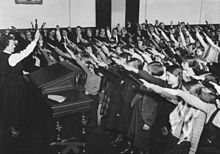
Nazi Germany, officially known as the German Reich and later the Greater German Reich, is a term used to describe the German state between 1933 and 1945, when Adolf Hitler and the Nazi Party controlled the country, transforming it into a totalitarian dictatorship. The Third Reich, meaning "Third Realm" or "Third Empire", referred to the Nazi claim that Nazi Germany was the successor to the earlier Holy Roman Empire (800–1806) and German Empire (1871–1918). The Third Reich, which the Nazis referred to as the Thousand-Year Reich, ended in May 1945, after only 12 years, when the Allies defeated Germany and entered the capital, Berlin, ending World War II in Europe.
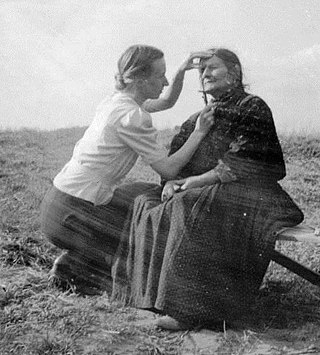
The racial policy of Nazi Germany was a set of policies and laws implemented in Nazi Germany under the dictatorship of Adolf Hitler, based on pseudoscientific and racist doctrines asserting the superiority of the putative "Aryan race", which claimed scientific legitimacy. This was combined with a eugenics program that aimed for "racial hygiene" by compulsory sterilization and extermination of those who they saw as Untermenschen ("sub-humans"), which culminated in the Holocaust.

The Hitler Youth was the youth organisation of the Nazi Party in Germany. Its origins date back to 1922 and it received the name Hitler-Jugend, Bund deutscher Arbeiterjugend in July 1926. From 1936 until 1945, it was the sole official boys' youth organisation in Germany and it was partially a paramilitary organisation. It was composed of the Hitler Youth proper for male youths aged 14 to 18, and the German Youngsters in the Hitler Youth for younger boys aged 10 to 14.
This is a list of words, terms, concepts and slogans of Nazi Germany used in the historiography covering the Nazi regime. Some words were coined by Adolf Hitler and other Nazi Party members. Other words and concepts were borrowed and appropriated, and other terms were already in use during the Weimar Republic. Finally, some are taken from Germany's cultural tradition.
Volksgemeinschaft is a German expression meaning "people's community", "folk community", "national community", or "racial community", depending on the translation of its component term Volk. This expression originally became popular during World War I as Germans rallied in support of the war, and many experienced "relief that at one fell swoop all social and political divisions could be solved in the great national equation". The idea of a Volksgemeinschaft was rooted in the notion of uniting people across class divides to achieve a national purpose, and the hope that national unity would "obliterate all conflicts - between employers and employees, town and countryside, producers and consumers, industry and craft".
A German Blood Certificate was a document provided by Nazi leader Adolf Hitler to Mischlinge, declaring them deutschblütig. This practice was begun sometime after the Nuremberg Laws of 1935, and allowed exemption from most of Germany's racial laws.

Blood and soil is a nationalist slogan expressing Nazi Germany's ideal of a racially defined national body ("Blood") united with a settlement area ("Soil"). By it, rural and farm life forms are idealized as a counterweight to urban ones. It is tied to the contemporaneous German concept of Lebensraum, the belief that the German people were to expand into Eastern Europe, conquering and displacing the native Slavic and Baltic population via Generalplan Ost.

Werner Goldberg was a German who was of half Jewish ancestry, or Mischling in Nazi terminology, who served briefly as a soldier during World War II. His image appeared in the Berliner Tageblatt as "The Ideal German Soldier", and was later used in recruitment posters and propaganda for the Wehrmacht.
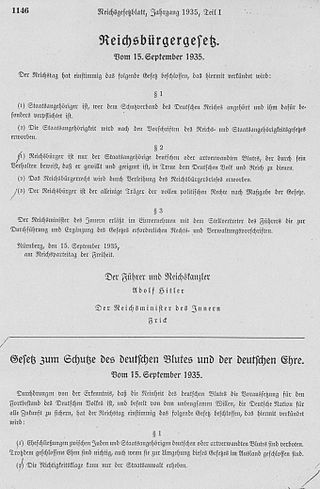
Rassenschande or Blutschande was an anti-miscegenation concept in Nazi German racial policy, pertaining to sexual relations between Aryans and non-Aryans. It was put into practice by policies like the Aryan certificate requirement, and later by anti-miscegenation laws such as the Nuremberg Laws, adopted unanimously by the Reichstag on 15 September 1935. Initially, these laws referred predominantly to relations between ethnic Germans and non-Aryans, regardless of citizenship. In the early stages the culprits were targeted informally; later, they were punished systematically and legally.

The Law for the Restoration of the Professional Civil Service, also known as Civil Service Law, Civil Service Restoration Act, and Law to Re-establish the Civil Service, was enacted by the Nazi regime in Germany on 7 April 1933. This law, which followed Adolf Hitler's rise to power by two months and the promulgation of the Enabling Act by two weeks, constituted one of the earliest instances of anti-Semitic and racist legislation in Germany.

The propaganda used by the German Nazi Party in the years leading up to and during Adolf Hitler's dictatorship of Germany from 1933 to 1945 was a crucial instrument for acquiring and maintaining power, and for the implementation of Nazi policies.

The Deutsches Jungvolk in der Hitlerjugend was the separate section for boys aged 10 to 13 of the Hitler Youth organisation in Nazi Germany. Through a programme of outdoor activities, parades and sports, it aimed to indoctrinate its young members in the tenets of Nazi ideology. Membership became fully compulsory for eligible boys in 1939. By the end of World War II, some had become child soldiers. After the end of the war in 1945, both the Deutsches Jungvolk and its parent organization, the Hitler Youth, ceased to exist.

Untermensch is a German language word literally meaning 'underman', 'sub-man', or 'subhuman', that was extensively used by Germany's Nazi Party to refer to non-Aryan people they deemed as inferior. It was mainly used against "the masses from the East", that is Jews, Roma, and Slavs.
The Nazi Party of Germany adopted and developed several pseudoscientific racial classifications as part of its ideology (Nazism) in order to justify the genocide of groups of people which it deemed racially inferior. The Nazis considered the putative "Aryan race" a superior "master race", and they considered Jews, black people, mixed-race people, Slavs, Roma, Africans and certain other ethnicities racially inferior "sub-humans", whose members were only suitable for slave labor and extermination. These beliefs stemmed from a mixture of historical race concepts, 19th-century anthropology, scientific racism, and anti-Semitism, especially racial anti-Semitism. The term "Aryan" generally originated during the discourses about the use of the term Volk.
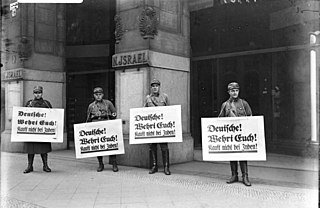
The Nazi boycott of Jewish businesses in Germany began on April 1, 1933, and was claimed to be a defensive reaction to the anti-Nazi boycott, which had been initiated in March 1933. It was largely unsuccessful, as the German population continued to use Jewish businesses, but revealed the intent of the Nazis to undermine the viability of Jews in Germany.
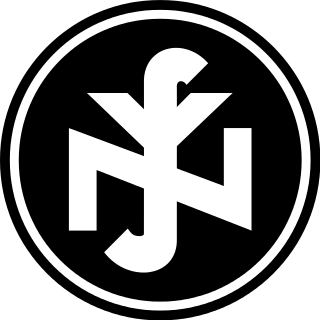
The National Socialist People's Welfare was a social welfare organization during the Third Reich. The NSV was originally established in 1931 as a small Nazi Party-affiliated charity, which was active locally in the city of Berlin. On 3 May 1933, shortly after the Nazi Party took power in Weimar Germany, Adolf Hitler turned it into a party organization that was to be active throughout the country. The structure of the NSV was based on the Nazi Party model, with local (Ort), county (Kreis) and district (Gau) administrations.
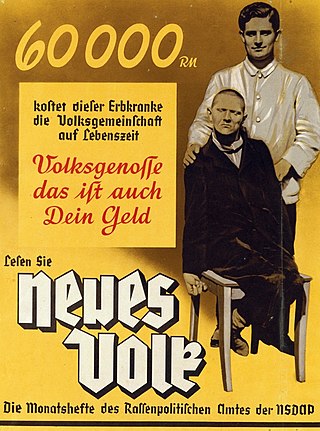
Neues Volk was the monthly publication of the Office of Racial Policy in Nazi Germany. Founded by Walter Gross in 1933, it was a mass-market, illustrated magazine. It aimed at a wide audience, achieving a circulation of 300,000. It appeared in physicians' waiting rooms, libraries, and schools, as well as in private homes.

The propaganda of the Nazi regime that governed Germany from 1933 to 1945 promoted Nazi ideology by demonizing the enemies of the Nazi Party, notably Jews and communists, but also capitalists and intellectuals. It promoted the values asserted by the Nazis, including Heldentod, Führerprinzip, Volksgemeinschaft, Blut und Boden and pride in the Germanic Herrenvolk. Propaganda was also used to maintain the cult of personality around Nazi leader Adolf Hitler, and to promote campaigns for eugenics and the annexation of German-speaking areas. After the outbreak of World War II, Nazi propaganda vilified Germany's enemies, notably the United Kingdom, the Soviet Union and the United States, and in 1943 exhorted the population to total war.
Nazism, the common name in English for National Socialism, is the far-right totalitarian socio-political ideology and practices associated with Adolf Hitler and the Nazi Party (NSDAP) in Germany. During Hitler's rise to power in 1930s Europe, it was frequently referred to as Hitlerism. The later related term "neo-Nazism" is applied to other far-right groups with similar ideas which formed after the Second World War when the Nazi regime collapsed.
Trust No Fox on his Green Heath and No Jew on his Oath! A Picture Book for Old and Young is an antisemitic children's picture book published in November 1936 in Nazi Germany. The book was written and illustrated by Elvira Bauer, a kindergarten teacher, art student, and Nazi supporter. It was the first of three children's books to be published by Julius Streicher, the editor of the infamously antisemitic newspaper Der Stürmer, who was later executed for war crimes.

![]() ). [1] Their practical methods of doing so included demonizing the previously existing independent youth organizations and replacing the concept and practice of youth hiking with marching in lock step. In fact, the Hitler Youth leadership officially banned the word "Wandern" (hiking) from their organization's language in 1937. [2]
). [1] Their practical methods of doing so included demonizing the previously existing independent youth organizations and replacing the concept and practice of youth hiking with marching in lock step. In fact, the Hitler Youth leadership officially banned the word "Wandern" (hiking) from their organization's language in 1937. [2] 



